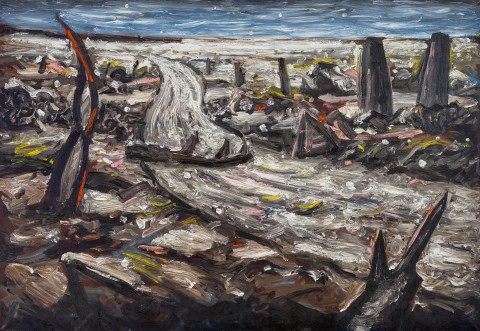WINTER, 1988
PETER BOOTH
oil on linen
167.0 x 243.0 cm
signed, dated and inscribed with title verso: Booth 1988 WINTER
Deutscher Fine Art, Melbourne
Private collection
Masterpiece Fine Art Gallery, Hobart
Private collection, Tasmania
Christie’s, Sydney, 13 August 2000, lot 96 (as ‘Winter Landscape, 1994’)
The Cbus Collection of Australian Art, Melbourne, acquired from the above
on loan to the University of Tasmania, Hobart, May 1996 – June 2000
Mute Reason, Latrobe Regional Gallery, Victoria, 27 April - 25 August 2013
on long term loan to Latrobe Regional Gallery, Victoria
Nainby, B., Stanhope, Z., and Furlonger, K., The Cbus Collection of Australian Art, in association with Latrobe Regional Gallery, Melbourne, 2009, pp. 17, 138 (illus.), 214
A key figure in the revival of figurative painting in Melbourne during the 1980s, Booth’s reputation as one of Australia’s most renowned contemporary painters was cemented in the early years of that decade when he was chosen (alongside Rosalie Gascoigne) to represent Australia at the Venice Biennale in 1982. Over the intervening decades since, he has only continued to attract further widespread acclaim with his highly expressive, energetic works which, depicting a world both imagined and observed, poignantly explore fundamental human emotions and anxieties, issues of spiritual turmoil, social alienation and the devolution of civilisation. Drawing upon epic legends of the past and prophecies for an imagined future, thus Booth's vision transcends the immediate or particular to acquire a universality comparable to the musings of his greatest artistic predecessors, including Goya, Blake and Shakespeare.
Charged with emotion and symbolic meaning, Winter, 1988 belongs to a transitional phase in Booth's oeuvre between his celebrated ‘apocalyptic’ paintings executed from 1977 to 1982, and the quiet chill of the snow paintings which he commenced during the winter of 1989. Influenced partly by his childhood years in Sheffield in England's industrial north, these works represented an important transition in the artist’s oeuvre which he paralleled to the journey in Milton's epic sequence of poems, Paradise Lost (1667) to Paradise Regained (1671). More specifically however, the series was inspired by the artist's re-reading of Shakespeare's Macbeth (1606) with its chilling themes of ambition and evil bearing resonance for Booth in contemporary Western greed and its blatant disregard for the planet. Accordingly, in many of these paintings, snow throws a white curtain of silence over a charred, blackened landscape, heralding the end of man's aggression towards his fellow man and the environment, like the omen of destruction foretold by the decimation of the Birnam wood in Macbeth.
Powerfully evoking the aftermath of some terrible disaster, vividly captured with agitated, heavily applied brushwork and menacing abstract forms blanketed in snow, Winter is an intense, dramatic work encapsulating well Booth's landscapes from this period. Perceiving in his art a loss of faith in civilisation, critics have thus not surprisingly interpreted such sombre, haunting images as premonitions against 'The Fall' – the possible downward trajectory of the present age towards barbarism and eventual extinction. Yet to focus solely upon the immediate, pessimistic impact of such works is to ignore the lyricism – even optimism – frequently underlying Booth's imagery. Indeed, discussing the snow motif specifically Jason Smith elucidates '...for Booth, the winter landscape is one of serenity and the promise of renewal. It reminds us of the resilience of nature and is a metaphor for human endurance against the physical and psychological trials of life...'1
1. Smith, J., 'Peter Booth: Human / Nature' in Peter Booth: Human / Nature, National Gallery of Victoria, Melbourne, 2003, pp. 14 – 15
VERONICA ANGELATOS
